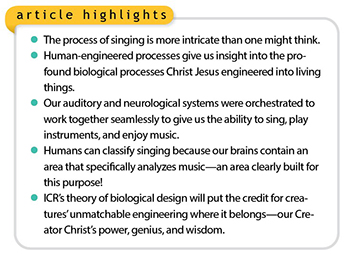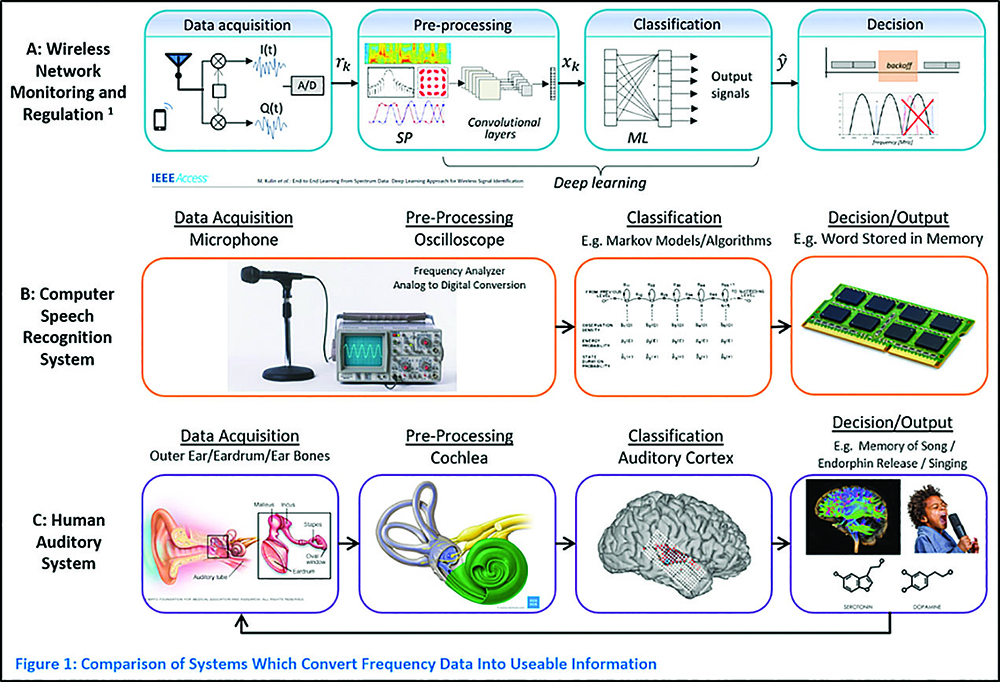by Randy J. Guliuzza and Aaron T. Guliuzza*

“Next time, won’t you sing with me?” is the closing line of the ABCs so often heard from sweet little voices. Since they don’t know it’s a rhetorical question, it’s amusing to hear them sing the song over and over…and over.
Yet, this endless singing produces lifelong benefits. It aids in brain development by establishing learning processes needed to assimilate astonishing amounts of information. Because singing plays an important role in development, it’d be interesting to know if any non-singing cultures have been identified. It also explains why technical literature links both the auditory and neurological systems together with singing and speaking.
When you think about it, these systems showcase many wonderful characteristics of the Lord Jesus. On the loving side, He made singing such a super-fun activity for toddlers that they gladly partake in this brain-building activity. The technical side is equally fascinating. He integrated the children’s auditory system into the brain’s “encoding” process. In this ABC song illustration, the children not only encode the ABCs but also the sequence of the 26 letters, two short musical arrangements, six musical notes (harmonic frequencies), a sentence, the rhetorical question, and the sounds of words (phonetics). There’s a lot more going on than meets the ear.
Exploring these interesting biological systems also illustrates ICR’s current work. As discussed in my article “Finding Biblical Clues to Design,” ICR is developing a theory of biological design.1 Key assumptions of this theory are demonstrated in a study of the auditory system and human singing.
Theory: A Framework Used to Explain Observations
A theory is a working hypothesis about how something works. A working hypothesis guides the development of research questions and shapes the interpretation of observations. Assumptions are central to theories. These are beliefs that are taken for granted as true, and scientists can use them to fit their religious beliefs into their theories.
For instance, many evolutionary biologists adhere to a religion called naturalism. Thus, when they approach biology, they’re assuming that life on Earth somehow started by natural processes, biological systems simply function rather than having goal-oriented purposes, genetic changes are almost universally random, and nature has the ability to somehow favor organisms. Since these assumptions automatically exclude many alternative explanations, they greatly simplify biology for the scientists.
Yet, these assumptions aren’t good illustrations of valid assumptions for scientific theories. Why? Because an assumption shouldn't be a guess or wild conjecture; it’s expected to be testable or have a rational basis tied to human experience. Evolutionary biologists are in the unenviable position of trying to explain the origin of creatures that give every indication of exquisite engineering—but without appealing to a real engineer.2 Nobody’s seen engineers design without a purpose or a complex entity spontaneously come into existence. Thus, the first article of faith for evolutionary biologists—i.e., that there’s no biological engineer—forces their assumptions to be counterintuitive to human experience.
ICR’s theory of biological design doesn’t force unreasonable assumptions. As we analyze the auditory system, we’ll see evidence that tends to reinforce three assumptions.
- Basic research of biological functions lies within the domain of engineering practice. Researchers systematically take the elements of biological systems apart piece by piece and apply tests to discern their operation. This practice is the definition of reverse engineering.
- An explanation for a biological function has a higher likelihood of being an accurate description if it incorporates the best tried-and-true principles used in human-produced designs (i.e., engineering principles).
- Analyzing human engineering practices is highly advantageous to biological research in formulating hypotheses about processes and informing research predictions, and it’s essential to guide researchers to correct explanations of the operation of biological phenomena. The last phrase is particularly important. It’s saying that when interpretations are framed within Darwin’s anti-design selectionist theory, researchers are immediately put on the path to irrational explanations about the origin and operation of biological phenomena.
God could have engineered creatures so that researchers couldn’t figure out their operation. But He did just the opposite. In fact, as human technology progresses, we observe an ever-increasing correspondence between the operation of highly engineered human devices and the systems in creatures that perform similar functions.3
This clear correspondence conveys powerful theological implications. First, it gives good reason to question the evolutionist’s assertion that humans and all other creatures are a “mere accident” of nature.4 There’s no rational basis for finding any correspondence between human-engineered products and random biological aftereffects. Second, since there’s no doubt that man-made things were engineered, then there shouldn’t be any doubt that creatures were also engineered.
The Auditory System and Corresponding Engineering Principles

Machines can record singing and graphically represent its many characteristics (e.g., intensity, timing, etc.). One example looks like Figure 1. How does the brain of a toddler make sense of all this data? We now have some answers. Like systems that engineers have devised, our auditory system and brain solve the same problem using the same engineering principles—but at exceedingly higher levels of performance.
Engineers methodically lay out all the elements necessary to solve problems. For example, engineers identified the necessary steps to track frequency data to optimize the efficiency of wireless networks (Figure 2A).5 Computer systems utilize the same arrangement for speech recognition (Figure 2B). Creatures use the same system elements to detect sounds, assign meaning to the data, and make decisions (Figure 2C).

Describing Four Corresponding Engineered Elements
1. A mechanism to convert air waves into useable data
Many sound-making devices compress air into pulses, and a system is needed for the initial pulse sensor and data converter. Human-engineered microphones and our ears fill this need and, as expected, have corresponding parts. Both have a membrane that flexes with air pulsations (our ear drum) connected to a mechanical linkage (the hammer, anvil, and stapes bones).
A fluid-filled chamber known as the cochlea located in our inner ear acts as a sound amplifier by transforming the vibrations conveyed by the linkage bones into fluid pulses. The movement of fluid in turn vibrates another sensor comprised of hundreds of tiny, yet highly sensitive, outer and inner hair cells that convert mechanical pulses to electrical signals.
2. A data preprocessor
The next step is to begin analyzing raw data. An oscilloscope is a device that produces a visual representation of the data from a microphone. The images help engineers study sound characteristics such as frequency (pitch) and amplitude (volume).
Similarly, humans have a remarkably sensitive frequency analyzer in our cochlea called the organ of Corti. So, imagine a piano with 16,000 keys. Your organ of Corti can recognize each distinct frequency. A built-in filtering feature allows us to simultaneously hear complex frequencies like a guitar chord of six strings or the harmony of a barbershop quartet. These parts work together so that “incoming sound pressure is transformed by the cochlea into vibrations of the basilar membrane which are then transformed in a series of neural impulses.”6
3. A classification and logic processor
Engineers develop algorithms that analyze data to classify incoming sounds into distinct categories such as speech. Humans perform the same function largely in our brain’s auditory cortex and other regions of the brain. The brain works at blindingly fast speeds that surpass even powerful computers, while using a tiny fraction of the energy. We rapidly distinguish between cars on a road, coins hitting the floor, or a cat’s purr. In an instant, we differentiate musical sounds as humming, whistling, vocal, instrumental…or singing toddlers.
This classification step highlights another corresponding engineering principle. Engineers design by working from the big picture down to individual parts. This goal-focused approach is called “top down.” That is, when a need arises, engineers design into an entity the up-front (i.e., innate) capability to meet the need.
We have the ability to rapidly classify sounds as singing because “the human brain contains a neural population specific to the analysis of song.”7 This unique area of the brain, which appears purpose-built to analyze singing, was identified by researchers studying people’s brains with magnetic resonance imaging (MRI) scans as they were exposed to various sounds. The results showed that “the response to sung music was substantially and significantly higher than the sum of the response to speech and instrumental music.”7
Even infants have a built-in ability to classify music. Our auditory and neuro-systems analyze rhythm patterns and group beats into regular meters. Research indicates that it’s a top-down “hard-wired” capability, given “that infants can impose a top-down, internally generated metre on ambiguous auditory rhythms, an ability that would aid early language and music learning.”8
4. Decisions and outputs
Computers can store processed sound data, manipulate it, display it on a screen, or even convert talk to text on your cell phone. Even though there are some profound differences between our brains and a computer, there are fascinating functional correspondences. After the auditory cortex processes data, the data are somehow “stored” for later access.
The auditory and the premotor cortex brain regions are also tightly integrated. One purpose of the premotor cortex is to queue up other parts of the brain and the body for motor movements when performing a sequence of learned activities—such as a balance beam routine, reciting the alphabet, or prompting the next song verse.9 This characteristic of the premotor cortex may contribute to the behavior of toddlers singing the same song repetitively, or might explain why adults can get a song stuck in their heads.
Crediting Christ as Creator for Our Musical Abilities
The Bible’s many references to singing make it clear that singing is important to the Lord. Singing elicits emotion, memories, anticipation, passion, and, in the spiritual sense, reverence and awe. It can calm or energize.
Compared to other communication methods, singing adds unique elements to communal worship. Listening to a church choir embodies a glorious demonstration of the spiritual unity of Christ’s body, the church. We witness multiple people sing different parts and integrate that harmony with a message of their shared beliefs into a cohesive whole. From the design perspective, we’ve barely scratched the surface in examining the corresponding engineering principles of our marvelous auditory system.
Yet, the world system of government, education, and entertainment has an anti-Christ agenda and seeks to corrupt our churches and families. When it comes to the origin of our auditory system, some evolutionists ask, “How did music and song selectivity arise over the course of development or evolution?” Their answer is that “unlike reading, singing could plausibly have shaped neural circuits over the course of evolution.”7
The creation scientists at ICR don’t believe that it’s enough to simply point out that evolutionists don’t have a clue about origins. Or to only expose their projection of selective abilities onto nature, a process that distorts nature into an idolatrous creative agent of auditory systems, thus rejecting God’s agency. ICR’s work to build a theory of biological design will magnify how the engineered workmanship seen in living creatures corresponds to the engineered workmanship of man-made things that perform similar functions—glorious evidence of unmatchable design that is the primary and undeniable revelation of Christ’s power, genius, and wisdom.
References
- Guliuzza, R. J. 2022. Finding Biblical Clues to Design. Acts & Facts. 51 (1): 4-6.
- Ayala, F. J. 2007. Darwin’s Greatest Discovery: Design without Designer. Proceedings of the National Academy of Sciences. 104 (suppl 1): 8567-8573.
- Khammash, M. 2008. Reverse engineering: the architecture of biological networks. BioTechniques. 44 (3): 323-328.
- Quoting Nobel laureate Jacques Monod. Judson, H. F. 1979. The Eighth Day of Creation. New York: Simon & Schuster, 217.
- Kulin, M. et al. 2018. End-to-End Learning from Spectrum Data: A Deep Learning Approach for Wireless Signal Identification in Spectrum Monitoring Applications. IEEE Access. 6: 18484-18501.
- Russo, M. et al. 2019. Robust Cochlear-Model-Based Speech Recognition. Computers. 8 (1): 5.
- Norman-Haignere, S. V. et al. 2022. A neural population selective for song in human auditory cortex. Current Biology. 32 (7): P1470-1484.e12.
- Flaten, E. et al. 2022. Evidence for top-down metre perception in infancy as shown by primed neural responses to an ambiguous rhythm. European Journal of Neuroscience. 55 (8): 2003-2023.
- Rauschecker, J. P. 2014. Is there a tape recorder in your head? How the brain stores and retrieves musical melodies. Frontiers in Systems Neuroscience. 8: 149.
* Dr. Guliuzza is President of the Institute for Creation Research. He earned his M.D. from the University of Minnesota, his Master of Public Health from Harvard University, and served in the U.S. Air Force as 28th Bomb Wing Flight Surgeon and Chief of Aerospace Medicine. Dr. Guliuzza is also a registered Professional Engineer and holds a B.A. in theology from Moody Bible Institute. Aaron Guliuzza is an Industrial Engineer with Molded Fiber Glass Companies who oversees production of composite wind turbine blades. He holds a B.S. in Industrial Engineering from South Dakota School of Mines and Technology.
















